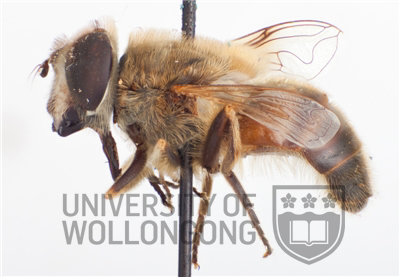Taxonomy
Family: Syrphidae
Subfamily: Eristalinae
Genus: Eristalis Latreille 1804
Subgenus: Eristalis (Latreille 1804)
Species: tenax (Linnaeus 1758)
The third-instar larva was described by Dixon (1960).
Biology
Eristalis tenax, also known as the drone fly, is a bee mimic that can be observed visiting flowers. The larvae, known as rat-tailed maggots, are adapted to an aquatic or semi-aquatic lifestyle (Smith 1986). The common name is derived from the long breathing tube that allows the larva to live in foul water containing decaying organic matter. Similar conditions may be observed in putrefying carrion containing liquid exudates. It is most commonly encountered in Australian forensic casework on partially submerged human corpses in fresh water. Eristalis tenax has also been recorded causing intestinal myiasis in humans (Zumpt 1965).
Distribution
Eristalis tenax is a cosmopolitan species, and probably occurs throughout Australia.
Relevant Literature
Dixon, T.J.
(1960). Key to and descriptions of the third instar larvae of some species of Syrphidae occurring in Britain.
Proceedings of the Royal Entomological Society of London 112, 345-379.
Smith, K.G.V. (1986) A manual of forensic
entomology. Ithaca, New York: Cornell University
Press.
Zumpt, F. (1965) Myiasis in man and
animals in the Old World. A textbook for physicians,
veterinarians and zoologists, London, Butterworth
and Co.
